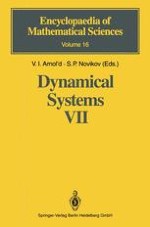1994 | Buch
Dynamical Systems VII
Integrable Systems Nonholonomic Dynamical Systems
herausgegeben von: V. I. Arnol’d, S. P. Novikov
Verlag: Springer Berlin Heidelberg
Buchreihe : Encyclopaedia of Mathematical Sciences
Enthalten in: Professional Book Archive
